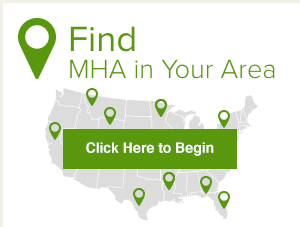You are here
Mental Health in America - Adult Data
Adult Ranking
States with high rankings have lower prevalence of mental illness and higher rates of access to care for adults. Lower rankings indicate that adults have higher prevalence of mental illness and lower rates of access to care.
The 7 measures that make up the Adult Ranking include:
- Adults with Any Mental Illness (AMI)
- Adults with Substance Use Disorder in the Past Year
- Adults with Serious Thoughts of Suicide
- Adults with AMI who Did Not Receive Treatment
- Adults with AMI Reporting Unmet Need
- Adults with AMI who are Uninsured
- Adults with Disability Who Could Not See a Doctor Due to Costs
Adult Prevalence of Mental Illness - Adults with Any Mental Illness (AMI)
18.07% of adults are experiencing a mental health illness. Equivalent to 44 million Americans.
4.13% are experiencing a severe mental health illness
The state prevalence of adult mental illness ranges from 15.50% in New Jersey to 22.61% in Oregon.
According to SAMHSA, “Any Mental Illness (AMI) is defined as having a diagnosable mental, behavioral, or emotional disorder, other than a developmental or substance use disorder. Any mental illness includes persons who have mild mental illness, moderate mental illness, and serious mental illness."
Adult with Substance Use Disorder in the Past Year
7.93% of adults in America reported having a substance use disorder in the past year;
2.76% an illicit drug use disorder in the past year;
6.09% an alcohol use disorder in the past year.
The state prevalence of adults with substance use disorder in the past year ranges from 6.33% in West Virginia to 10.59% in the District of Columbia.
Substance Use Disorder is defined as meeting criteria for illicit drug or alcohol dependence or abuse. Illicit Drug Use includes the misuse of prescription psychotherapeutics or the use of marijuana, cocaine (including crack), heroin, hallucinogens, inhalants, or methamphetamine. Misuse of prescription psychotherapeutics is defined as use in any way not directed by a doctor, including use without a prescription of one's own; use in greater amounts, more often, or longer than told; or use in any other way not directed by a doctor. Prescription psychotherapeutics do not include over-the-counter drugs.
Adults with Serious Thoughts of Suicide
The percentage of adults reporting serious thoughts of suicide is 4.04%.
The estimated number of adults with serious suicidal thoughts is over 9.8 million—an increase of 200,000 people from last year’s data set .
The state prevalence of adults with serious thoughts of suicide range from Florida at 3.34% to Utah at 5.62%.
Adults with AMI who are Uninsured
12.2% (over 5.3 million) of adults with a mental illness remain uninsured.
Under the Affordable Care Act (ACA), the US continues to see a decline in Americans who are uninsured. There was a 2.5% reduction from last year’s dataset.
46 states saw a reduction in Adults with AMI who are uninsured. The largest reductions were seen in South Carolina (7.1%), Missouri (6.3%), Arkansas (6.7%), Arizona (5.6%).
The state prevalence of uninsured adults with mental illness ranges from 2.2% in Massachusetts to 23.0% in Texas.
Adults with AMI who Did Not Receive Treatment
56.4% of adults with a mental illness received no treatment. Lack of access to treatment is slowly improving.
Over 24 million individuals experiencing a mental health illness are going untreated.
The state prevalence of untreated adults with mental illness ranges from 41.5% in Maine to 67.5% in Hawaii.
Adults with AMI Reporting Unmet Need
One out of five (20.6%) adults with a mental illness reported that they were not able to receive the treatment they needed. This number has not declined since 2011.
Individuals seeking treatment but still not receiving needed services face the same barriers that contribute to the number of individuals not receiving treatment:
- No insurance or limited coverage of services
- Shortfall in psychiatrists, and an overall undersized mental health workforce.
- Lack of available treatment types (inpatient treatment, individual therapy, intensive community services).
- Disconnect between primary care systems and behavioral health systems.
- Insufficient finances to cover costs – including, copays, uncovered treatment types, or when providers do not take insurance.
The state prevalence of adults with AMI reporting unmet treatment needs ranges from 15.8% in Hawaii to 26.3% in the District of Columbia.
.
Adults with Disability Who Could Not See a Doctor Due to Costs
21.62% of adults with a disability were not able to see a doctor due to costs. An estimated 47% of adults are not receiving treatment because of costs.
According to the US Census Bureau (2010) 56.7 million individuals had a level of disability, with more than half reporting that their disability was severe.
Of adults (15-64) who were uninsured, 21% had a severe disability.
A review of literature on the barriers to healthcare faced by individuals with disabilities found that having no insurance, a lack of insurance coverage, and no usual source of care were the most common barriers.
The prevalence of adults with disability who couldn’t see a MD due to cost ranges from 12.45% in Hawaii to 30.91% in Mississippi.







this page